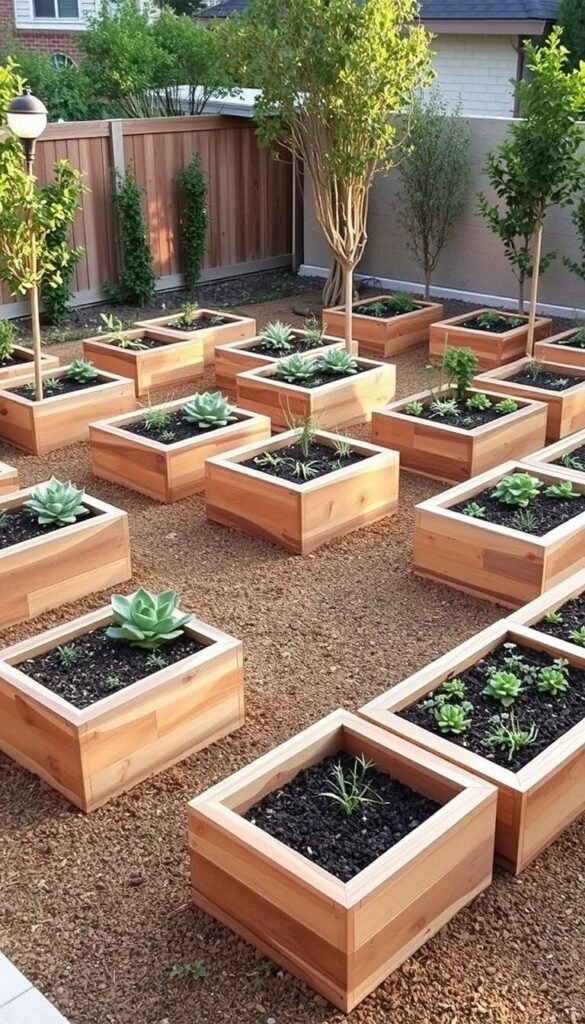Transforming your outdoor space starts with smart layouts that maximize growth and beauty. Whether you’re working with a cozy patio or acres of land, modular systems let you build a thriving green oasis. Think of these setups as puzzle pieces – arrange them to match your unique needs.
Imagine combining vertical planters with curved borders or nesting compact layouts within larger ones. The best part? These adaptable configurations grow with your ambitions. Start small, then expand as your confidence – or tomato harvest – increases.
We’ll show you how to blend practicality with visual appeal. Properly planned beds reduce maintenance while boosting yields. You’ll learn to position sun-loving herbs and shade-tolerant greens in harmonious patterns that make every square foot count.
From urban balconies to country estates, these foundational blueprints work across climates and soil types. Discover how strategic spacing and material choices create gardens that flourish year after year. Let’s turn your yard into a living masterpiece that feeds both body and soul.
Introduction: Transforming Your Backyard with Raised Garden Beds
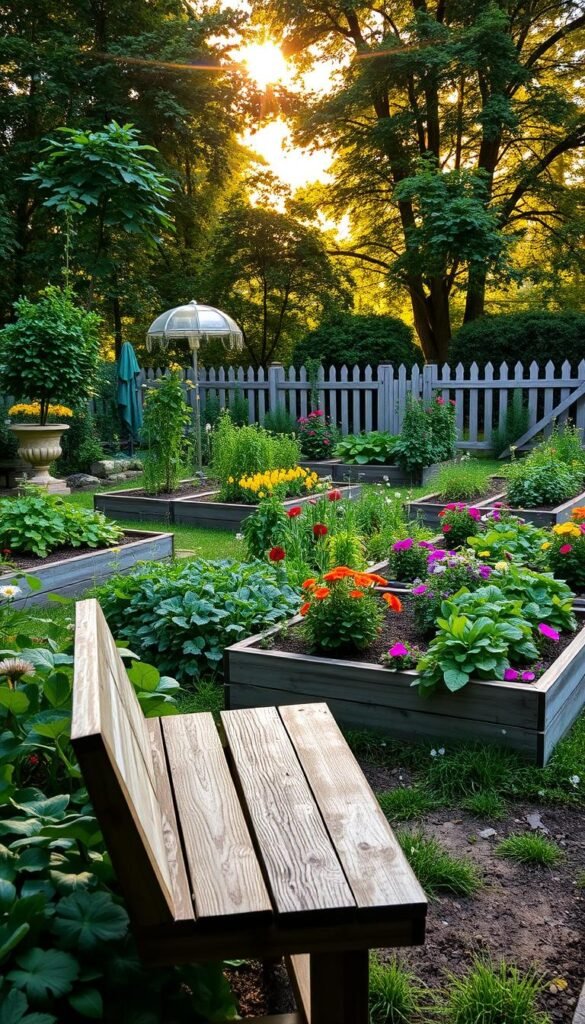
Building a thriving green space evolves through strategic planning rather than overnight miracles. Families often begin with sprawling lawns for play areas, then slowly introduce raised beds as children grow older. This phased approach lets you balance recreation with fresh harvests without overwhelming your schedule.
Swap unused turf for vibrant growing zones that serve multiple purposes. A 6×4-foot bed can yield 50 lbs of tomatoes annually while adding visual interest. Research shows households with edible landscapes spend 40% more time outdoors together, blending relaxation with practical tasks.
| Feature | Traditional Lawn | Raised Beds |
|---|---|---|
| Weekly Maintenance | 2 hours mowing | 30 mins harvesting |
| Annual Yield | 0 lbs produce | 80-120 lbs veggies |
| Family Engagement | Limited interaction | Hands-on learning |
Well-designed layouts do more than grow food – they become memory-making hubs. Studies reveal families with accessible planting areas report stronger bonds through shared activities. Start with one sunlit corner, then expand as your confidence blooms.
Your home environment deserves this gradual metamorphosis. Sketch a 3-year vision that turns unused corners into strawberry patches or pollinator havens. Small, intentional changes create lasting impact without draining resources.
Understanding the Benefits of Raised Beds in Your Garden
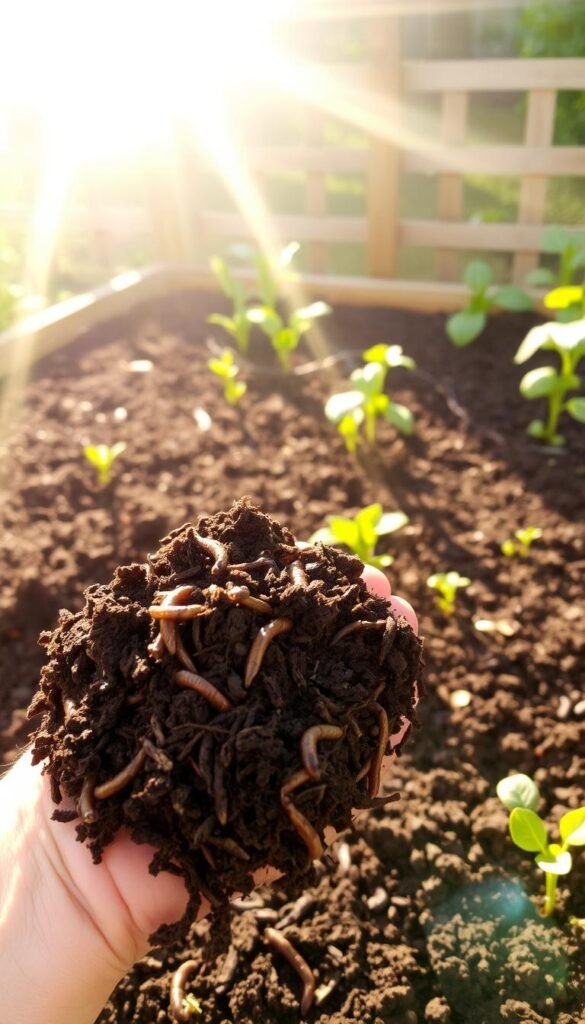
Gardening success often comes down to foundation choices. Unlike traditional plots, elevated setups give you command over your growing environment. This control translates to healthier greens and fewer frustrations.
Enhanced Soil and Plant Health
Your soil quality becomes a superpower with contained growing areas. Mix in compost, perlite, and organic matter to create ideal root habitats. These custom blends drain better than most native earth, preventing waterlogged roots during spring rains.
Warmer soil temperatures kickstart seed germination weeks earlier. Cornell University research shows elevated beds extend growing seasons by 2-4 weeks in cooler climates. Deeper root systems develop freely without compacted layers, leading to sturdier stems and abundant fruit production.
Maximized Space and Productivity
Every square inch works harder in organized layouts. Narrower dimensions let you reach all plants without stepping on soil, preserving its fluffy texture. Try companion planting – pair basil with tomatoes to deter pests naturally while doubling harvests.
| Feature | Raised Beds | In-Ground |
|---|---|---|
| Soil Customization | Full control | Limited options |
| Weed Competition | 70% less | High |
| Accessibility | Waist-high options | Ground-level only |
Vertical stacking multiplies yields. Train cucumbers up trellises while lettuce thrives below. You’ll harvest 4x more crops per season compared to conventional row planting. Maintenance time drops as weeds struggle to invade defined spaces.
Raised Garden Bed Plans: Top 5 Designs for Any Backyard Size
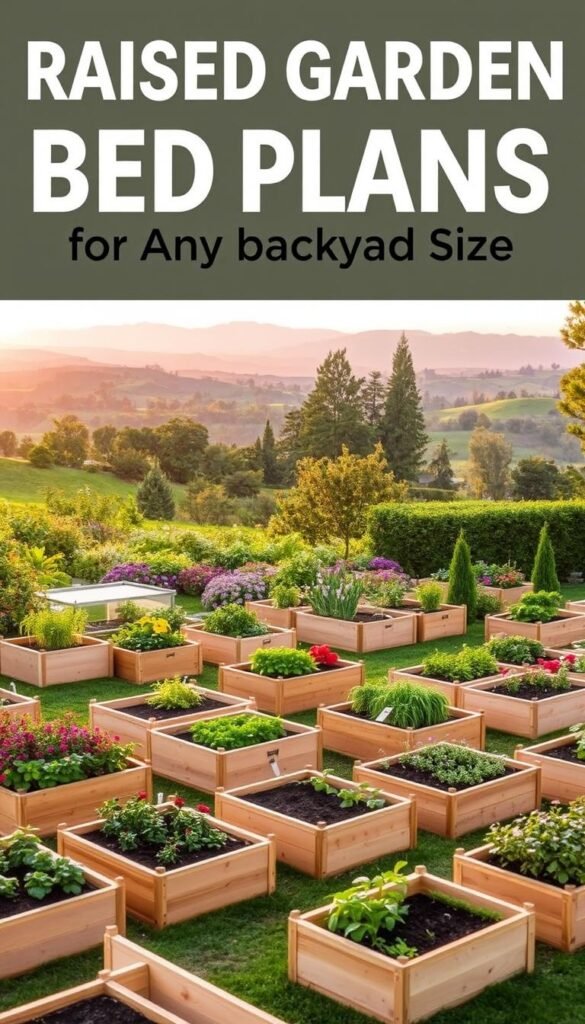
Unlock your yard’s potential through modular configurations that evolve with your needs. These five foundational layouts act like botanical building blocks – combine them to solve spatial puzzles while creating eye-catching patterns.
Exploring Diverse Layouts Like Garden Trio and L-Shaped Designs
The Garden Trio shines in tight spaces. Three triangular beds form a hexagon, giving you 360° access while fitting neatly against fences or between walkways. Pair it with an L-shaped border design to frame patios or wrap around trees, turning awkward edges into lush growing areas.
Larger properties benefit from symmetrical Twin Gardens or geometric Formal Potager arrangements. One urban gardener shared: “Mixing these styles let me create a kitchen garden that feels both organized and wild.”
Customizing Your Layout to Fit Your Unique Space
Start by mapping sun patterns and foot traffic. Narrow side yards? Try vertical corner beds with integrated trellises. Expansive lawns? Layer circular and rectangular shapes using expert-approved raised bed configurations.
Remember: Your space should work for you. A Minnesota family combined four Garden Trios with winding paths, tripling their harvest while creating a playful exploration zone for kids. Use square foot gardening principles to maximize every inch without overcrowding plants.
Choosing the Perfect Materials for Your Raised Beds
Your material choices determine whether your growing space thrives for seasons or crumbles mid-project. Quality matters more than upfront savings – think of this as a multi-year partnership with your plants.
Budget-Friendly Options Versus Long-Term Durability
Untreated pine costs less initially but may rot within 3 years. Composite materials resist decay but lack natural aesthetics. Cedar strikes a balance with 10-15 year durability and warm visual appeal, despite recent price hikes.
| Material | Cost (per 8ft) | Lifespan | Maintenance |
|---|---|---|---|
| Pine | $12 | 2-4 years | High |
| Cedar | $28 | 10-15 years | Low |
| Corten Steel | $65 | 25+ years | None |
Corten steel offers industrial charm and unmatched longevity. Its rust-like patina develops naturally, blending with outdoor environments. While pricier, it becomes cost-effective over decades – perfect for permanent installations.
Consider climate when selecting materials. Humid regions demand rot-resistant woods or metal. For durable gardening solutions, prioritize weatherproof options that match your soil type. A Midwest gardener shared: “Switching to steel saved me $200 in replacement costs over five years.”
Invest wisely – your future self will thank you when neighbors rebuild while you harvest.
Innovative Raised Bed Layouts to Maximize Your Garden Space
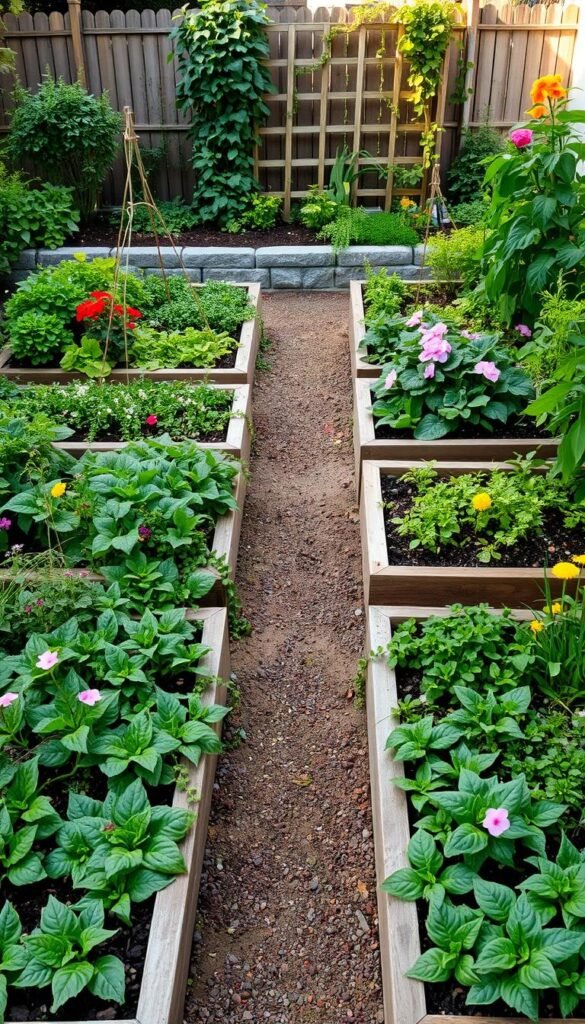
Smart spatial planning turns overlooked areas into thriving green zones. North-south oriented beds capture sunlight evenly, while three-foot pathways keep maintenance simple. Imagine transforming awkward corners into strawberry patches or tool stations.
L-Shaped, Border, and Twin Bed Designs
L-shaped configurations hug fences or wrap around seating areas, creating natural boundaries. One gardener reported: “Our border design frames the patio with herbs – guests smell rosemary before they see it!” Twin layouts offer mirrored planting zones ideal for testing soil amendments or plant varieties.
Consider these space-saving benefits:
- Border beds along walkways yield 15% more veggies than traditional rows
- 16 whiskey barrel planters add movable color accents
- 4×4 central garden beds become focal points
Functional Corners and Mobile Growing
Dead zones transform into composting hubs or vertical trellis stations. A Minnesota family uses triangular corners for dwarf fruit trees, saving 40 sq ft. Rotate container gardens seasonally – move peppers to sunnier spots as shadows shift.
Remember: Your layout should work harder than your shovel. Strategic designs blend beauty with bushels of homegrown goodness.
DIY Raised Bed Building: Best Practices and Pitfalls
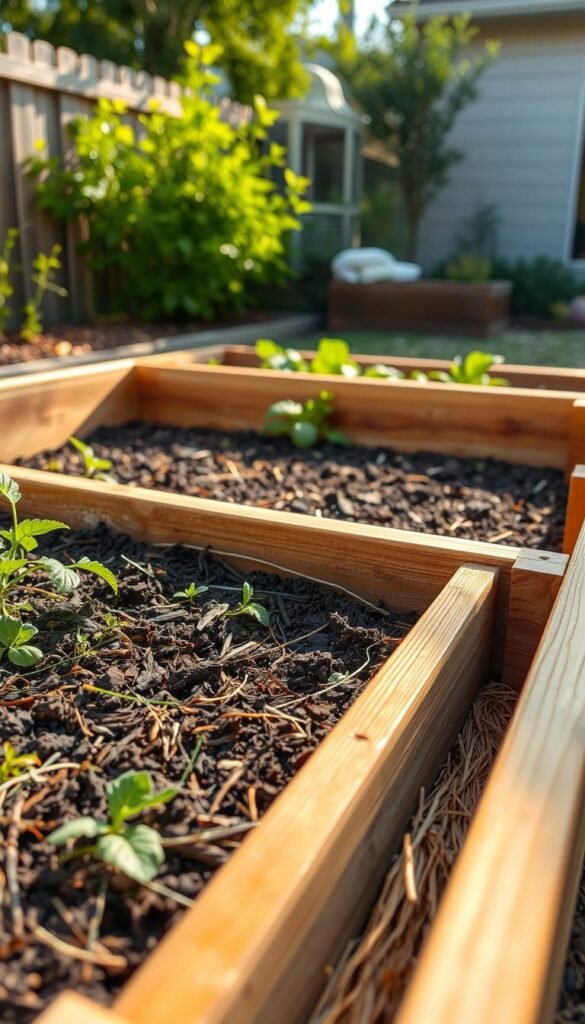
Building your own planters brings immense satisfaction, but common oversights can turn excitement into frustration. Tackle the toughest tasks first – like leveling ground or assembling corners – while your energy peaks. This “worst first” approach prevents half-finished projects when motivation wanes.
Tools That Transform Your Workflow
Equip yourself properly from day one. A cordless drill speeds up assembly, while a miter saw ensures clean cuts. For small beds, these essentials get the job done:
- Clamps for stable joint alignment
- Carpenter’s square for 90° angles
- Gloves to prevent splinters
Mistakes That Cost Time and Money
Many gardeners regret skipping these steps:
- Measuring twice but cutting once
- Using untreated wood in damp climates
- Forgetting vehicle size when buying lumber
One builder shared: “I returned home with 10-foot boards sticking out my sedan’s windows – delivery fees would’ve saved three trips!”
| Task | Time Saver | Common Error |
|---|---|---|
| Foundation Prep | Weed barrier fabric | Ignoring slope |
| Material Transport | Roof racks | Overloading vehicle |
| Joint Construction | Corner brackets | Nails only |
When in doubt, ask for help. Professionals can assist with complex designs or soil prep – sometimes worth the cost. Your time matters more than stubborn DIY pride.
Advanced Garden Design: Merging Raised Beds with Container Gardening
Blending permanent structures with mobile planters creates living landscapes that shift with the sun. Containers act as sunlight chasers – their portability lets you optimize growing conditions weekly. Pair them with anchored raised bed layouts to create a responsive ecosystem that thrives in every season.
Seasonal Placement for Optimal Growth
Winter’s low light demands smart positioning. Move pots to south-facing walls where they’ll soak up scarce rays. One Oregon gardener noted: “My kale thrives in movable planters while my permanent beds sleep under frost blankets.”
| Season | Container Placement | Raised Bed Focus | Yield Boost |
|---|---|---|---|
| Winter | Sun-trapping zones | Cover crops | +35% leafy greens |
| Summer | Morning sun areas | Heat-loving crops | +50% fruiting plants |
Rotate planters as shadows lengthen in summer. Position tomatoes in morning light, then shift herbs to afternoon shade. This dance prevents scorching while keeping harvests steady.
Match container sizes to your mobility needs. Lightweight fiberglass works for frequent moves, while cast concrete stays put for focal points. Blend textures – try pairing sleek metal troughs with rustic wood beds for visual harmony.
Remember: Your garden design should flow like nature – adaptable yet structured. Track sun patterns monthly, adjusting pot locations during watering routines. This seamless integration turns rigid layouts into living, breathing spaces.
Creative Uses for Trellises, Corners, and Garden Containers
Your growing zones become powerhouses when you think beyond ground level. Strategic vertical elements and smart corner solutions turn underused spaces into productive hubs. Let’s explore how to squeeze every drop of potential from your layout.
Maximizing Space with Multi-Functional Areas
Position trellises on northern bed edges to protect sun-loving plants. This placement lets climbing beans or cucumbers reach skyward without stealing light from peppers below. One urban grower shared: “My pea vines create living shade for heat-sensitive lettuce – it’s like natural air conditioning!”
Awkward corners transform into workhorses with these ideas:
- Compact compost stations behind dwarf fruit trees
- Stacked planters for herbs near kitchen doors
- Rainwater collection barrels doubling as trellis bases
| Zone | Primary Function | Seasonal Use |
|---|---|---|
| North Wall | Trellis system | Summer vines/Winter greens |
| South-East Corner | Container nursery | Spring starts/Fall storage |
| West Fence | Tool station | Year-round access |
Rotate containers to chase sunlight through shifting seasons. Group pots on wheeled platforms for easy repositioning. In summer’s peak, move heat-sensitive greens to shaded areas while tomatoes soak up full rays elsewhere.
These adaptable approaches let single spaces serve multiple roles. That sunny corner? Spring seedling hub becomes autumn pumpkin display. Your garden evolves daily while maintaining order – no wasted real estate.
Planning Your Garden Layout: Sunlight, Shade, and Microclimates
Smart garden layouts begin with understanding your land’s natural rhythms. Track how light dances across your space through seasons – summer’s high arc versus winter’s low glide. This awareness helps position plants where they’ll thrive, not just survive.
Observing Sun Patterns and Seasonal Shifts
Start with a sun map. Note where shadows fall at 9 AM, noon, and 3 PM during spring and fall. These transitional seasons reveal patterns affecting cool-weather crops. Morning light with afternoon shade prevents leafy greens from bolting too quickly.
| Tracking Method | Tools Needed | Best For |
|---|---|---|
| Sun Mapping | Compass, notebook | Identifying 6-8 hour zones |
| Shadow Tracing | Stakes, string | Visualizing tree coverage |
| Tech-Assisted | Sun tracker apps | Urban yards with structures |
Watch water movement during storms. Sloped areas might need swales to redirect runoff. One Oregon gardener shared: “Redirecting rainwater doubled my blueberry harvest – nature’s irrigation system!”
Designing for Diverse Microclimate Zones
Your yard contains multiple growing environments. South-facing walls radiate heat for tomatoes, while north-facing areas suit shade-loving hostas. Use existing trees as windbreaks for delicate seedlings.
Create microclimates with these techniques:
- Stone walls that store daytime heat
- Raised mounds for drainage in wet zones
- Potted plants to chase shifting sun patches
Adjust your design as you learn. A sunny spring spot might become shaded when maples leaf out. Stay flexible – your landscape’s secrets reveal themselves slowly.
Transforming Your Lawn into a Productive Raised Bed Garden
Your green revolution begins where play areas meet practicality. Many yards have underused turf zones that could be bursting with basil instead of grass. Start by converting a sunny lawn corner into your first raised bed – even a 4×4-foot plot yields surprising harvests.
Repurposing Unused Spaces for Growth
As kids grow older or hobbies change, that sprawling lawn might become more chore than charm. One family first started with a tiny herb garden area near their patio. Over five years, they replaced 60% of their grass with strawberry patches and dwarf fruit trees.
Consider these transitions:
• Convert worn play zones into curved raised beds with bench seating
• Turn shady spaces into mushroom-growing stations
• Use former pet runs for vertical planters
Your garden evolves alongside your life. A once-busy soccer field becomes a tranquil meditation space edged with lavender. Every change preserves what matters while adding fresh purpose. Start today – your future harvests will thank you.

